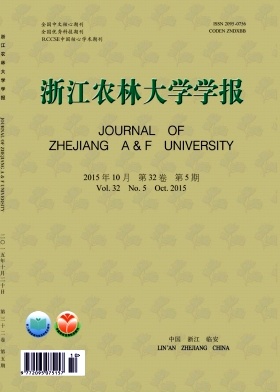| [1] |
HAO Lihui, DONG Bin, ZHU Shaohua, MA Jin.
Transcriptome analysis and PsHSP gene expression of Paeonia suffruticosa in response to high temperature stress
. Journal of Zhejiang A&F University,
2021, 38(4): 802-811.
doi: 10.11833/j.issn.2095-0756.20200529
|
| [2] |
XIE Dezhi, WEI Zilu, ZHU Junyi, DU Ying, JIN Shuihu, YUE Chunlei.
Physiological responses of Hygroryza aristata to cadmium stress
. Journal of Zhejiang A&F University,
2020, 37(4): 683-692.
doi: 10.11833/j.issn.2095-0756.20190407
|
| [3] |
HOU Panpan, CHEN Anliang, FEI Libin, MA Liangjin.
Resistance of Phoebe sheareri to anthracnose induced by salicylic acid
. Journal of Zhejiang A&F University,
2020, 37(3): 605-610.
doi: 10.11833/j.issn.2095-0756.20190342
|
| [4] |
LI Nan, LI Hepeng, JIANG Bo, YE Bihuan, CHEN Youwu, LI Haibo.
Physiological response to low temperature stress in Casuarina equisetifolia seedlings
. Journal of Zhejiang A&F University,
2019, 36(4): 678-686.
doi: 10.11833/j.issn.2095-0756.2019.04.007
|
| [5] |
WANG Yingying, ZHAO Bing, LI Ying.
Heat resistance of Rhododendron with arbuscular mycorrhizal fungi
. Journal of Zhejiang A&F University,
2019, 36(4): 733-740.
doi: 10.11833/j.issn.2095-0756.2019.04.013
|
| [6] |
HAN Yilin, WANG Xinzhao, XU Xinlu, GAO Yan, WEN Guosheng, ZHANG Rumin, WANG Yukui.
Responses of anti-oxidant enzymes and the ascorbate-glutathione cycle to heat, drought, and synergistic stress in Phyllostachys edulis seedlings
. Journal of Zhejiang A&F University,
2018, 35(2): 268-276.
doi: 10.11833/j.issn.2095-0756.2018.02.010
|
| [7] |
LI Li, SONG Shuaijie, FANG Xiaomei, YANG Lizhi, SHAO Shanlu, YING Yeqing.
Protection enzymes and lipid peroxidation in Phyllostachys edulis seedlings with temperature and water stresses
. Journal of Zhejiang A&F University,
2017, 34(2): 268-275.
doi: 10.11833/j.issn.2095-0756.2017.02.010
|
| [8] |
WEI Wei, LI Junmin, SUN Liying, RONG Junkang, ZHOU Wei.
Selection of wheat having resistance to yellow mosaic virus and screen out SSR molecular markers having polymorphism between resistant and sensitive parents
. Journal of Zhejiang A&F University,
2016, 33(1): 71-79.
doi: 10.11833/j.issn.2095-0756.2016.01.010
|
| [9] |
JIA Sizhen, YANG Hengwei, YAN Zhiming, WEI Yue.
Physiological and biochemical indexes of exogenous salicylic acid on chrysanthemum seedlings with high temperature stress
. Journal of Zhejiang A&F University,
2016, 33(3): 449-454.
doi: 10.11833/j.issn.2095-0756.2016.03.011
|
| [10] |
WANG Qingling, LIU Wenxin, ZHAO Jiaping.
Expression patterns for a PdERF-18 response to different stresses in Populus deltoides 'Shanhaiguan'
. Journal of Zhejiang A&F University,
2014, 31(5): 716-723.
doi: 10.11833/j.issn.2095-0756.2014.05.009
|
| [11] |
YE Xiao-qi, WU Ming, WANG Qi, JIANG Ke-yi, SHAO Xue-xin.
Correlation of seed germination capacities under salt stress with four plant species distribution in the Hangzhou Bay Wetlands
. Journal of Zhejiang A&F University,
2012, 29(5): 739-743.
doi: 10.11833/j.issn.2095-0756.2012.05.017
|
| [12] |
ZHU Lan, LI Xue-qin, JIA Xiao-lin, WANG Bin, JIN Song-heng.
High temperature stress with photosynthesis in Festuca arundinacea
. Journal of Zhejiang A&F University,
2009, 26(5): 652-655.
|
| [13] |
DU Guo-jian, MIAO Yu- ming, CHEN Zhuo-mei, ZHANG Yue-xian, CHEN Ya-fei.
Resistance and absorbency to gaseous chlorine with 37 young landscaping plant species
. Journal of Zhejiang A&F University,
2009, 26(4): 503-510.
|
| [14] |
ZHAO Zhi-xin, QIAO Rui-fang, JI Kong-shu.
Cadmium stress on growth and resistance of hybrid tulip trees:Liriodendron chinense × Liriodendron tulipifera
. Journal of Zhejiang A&F University,
2009, 26(5): 667-673.
|
| [15] |
MIAO Yu-ming, CHEN Zhuo-mei, CHEN Ya-fei, DU Guo-jian.
Resistance to and absorbency of gaseous NO2 for 38 young landscaping plants in Zhejiang Province
. Journal of Zhejiang A&F University,
2008, 25(6): 765-771.
|
| [16] |
CHEN Zhuo-mei, DU Guo-jian, MIAO Yu-ming.
Resistance to and absorption of gaseous HF with 38 landscaping plant species in Zhejiang Province
. Journal of Zhejiang A&F University,
2008, 25(4): 475-480.
|
| [17] |
CAO Fu-liang, OU Zu-lan.
Ginkgo biloba seedling tolerance to high-temperature stress using salicylic acid
. Journal of Zhejiang A&F University,
2008, 25(6): 756-759.
|
| [18] |
WANG Shu-feng, CHEN Yi-tai, PAN Hong-wei, WU Tian-lin.
Changes of physiological characteristics of eight Alnus cremastogyne clones under salt stress
. Journal of Zhejiang A&F University,
2006, 23(1): 19-23.
|
| [19] |
LI Ji-yuan, LI Xin-lei, FAN Miao-hua, TIAN Min, FAN Zheng-qi.
Heat tolerance of 15 Camellia cultivars under heat stress
. Journal of Zhejiang A&F University,
2006, 23(6): 636-640.
|
| [20] |
PU Guang-lan, YUAN Da-gang, HU Xue-hua, ZHOU Lan-ying, DENG Jia-lin, LIU Yong-hong.
Effect of soil drought stress on physiological and biochemical characteristics in three Armeniaca vulgaris cultivars
. Journal of Zhejiang A&F University,
2005, 22(4): 375-379.
|






 DownLoad:
DownLoad: